Dieffenbachia Plant (Leopard Lily) Care – Growing Dumb Cane Plant
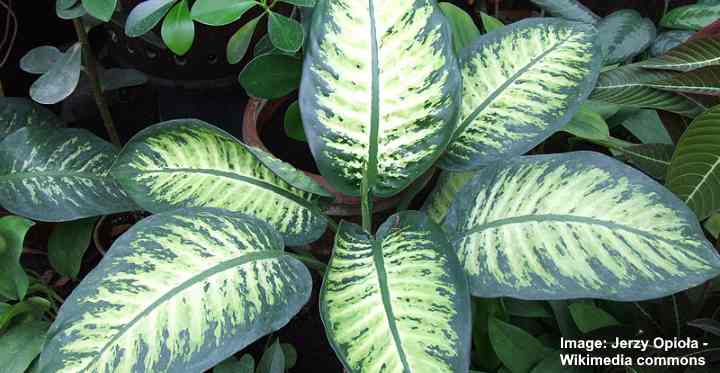
Dieffenbachia—also called the dumb cane plant—is a type of ornamental houseplant that comes from the tropics. Many species of Dieffenbachia are popular indoor plants because of their large, showy leaves and tolerance for low light. Types of dumb cane plants such as Dieffenbachia seguine, Dieffenbachia amoena, and Dieffenbachia Camille have attractive variegated creamy-white and green leaves. The beauty of Dieffenbachia plants is that they are so easy to care for at home.
How to care for types of Dieffenbachia: Dumb cane plants thrive in low to medium light, growing in a moist potting mix, and average humidity. Water Dieffenbachia plants thoroughly when the top inch of soil is dry. Keep the temperature between 65°F and 75°F (18°C – 23°C) and fertilize monthly from spring until summer.
Dumb cane plants are in the genus Dieffenbachia which is native to the tropics in Central and South America. These plants grow quickly in bright light as long as they are protected from direct sunlight. Large leaves grow from a central stem or cane and grow up to 10” (25 cm) wide and 20” (47 cm) long. These tropical houseplants rarely—if ever—flower indoors.
This article is a guide on growing all types of indoor Dieffenbachia plants. You will also learn how to deal with issues that can affect the growth of these beautiful foliage plants.
Varieties of Dieffenbachia Plants
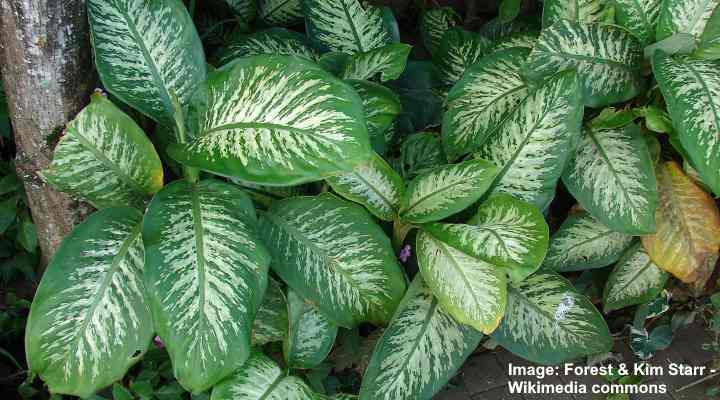
Dieffenbachia plants have various types and cultivars with attractive leaf patterns. In this picture: Dieffenbachia seguine
Different types of dumb cane plants are classified by the fascinating pattern on their large, broad leaves. Let’s look briefly at some of the most common species of Dieffenbachia, also called the leopard lily.
Some plants in the Dieffenbachia species have large yellowish or creamy leaves with green margins. Examples of these variegated plants include Dieffenbachia maculata ‘Camille,’ Dieffenbachia ‘Tropical Marianne,’ Dieffenbachia ‘Honeydew,’ and Dieffenbachia ‘Tropic Honey.’
Other types of dumb cane plants have mostly dark or light green leaves with white or yellow veins. Some kinds of these plants are Dieffenbachia seguine, Dieffenbachia amoena, Dieffenbachia picta, and some Dieffenbachia maculata cultivars.
How to Care for Dumb Cane (Dieffenbachia) Plants at Home
Although Dieffenbachia is an easy-to-care-for plant species, there are a few essential care tips you should know. Looking after your ornamental plants properly will help them to thrive.
Dieffenbachia (Dumb Cane) Light Requirements
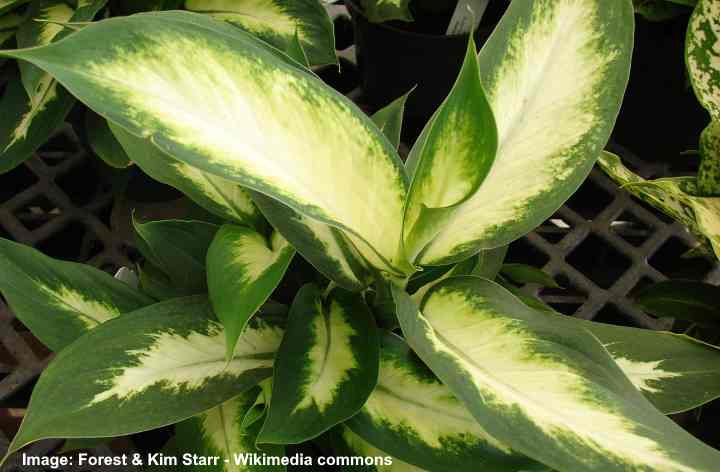
Dieffenbachia maculata ‘Camille’ has yellowish leaves with green margins
Dumb cane plants generally need medium to bright, indirect sunlight to thrive. Even though Dieffenbachia can grow in low-light conditions, bright light keeps the variegated leaves vibrant. Also, plenty of light is needed to maintain vigorous growth. Leaves that become discolored is a common sign of too much direct sunlight.
The best location for Dieffenbachia plants is a bright, east-facing windowsill. The early morning sun and bright spot are ideal for healthy growth. If you grow your dumb cane plants in a west- or south-facing room, keep them away from the window or have the plants behind a sheer curtain.
Generally, the types of Dieffenbachia that grow best in low light are ones with darker leaves. So, species such as Dieffenbachia ‘Snow,’ Dieffenbachia seguine, and Dieffenbachia maculata are ideal for low-light rooms and offices.
Some types of dumb cane plants grow better in low light conditions than others. If you notice that the plant’s canes or stems become leggy, it could be a sign that the plant needs more sunlight. Also, leaf drop is another sign of insufficient light. When growing in the dark, most dumb can plants remain healthy, although growth will slow down to a minimum.
The Best Potting Soil for Dieffenbachia Plants
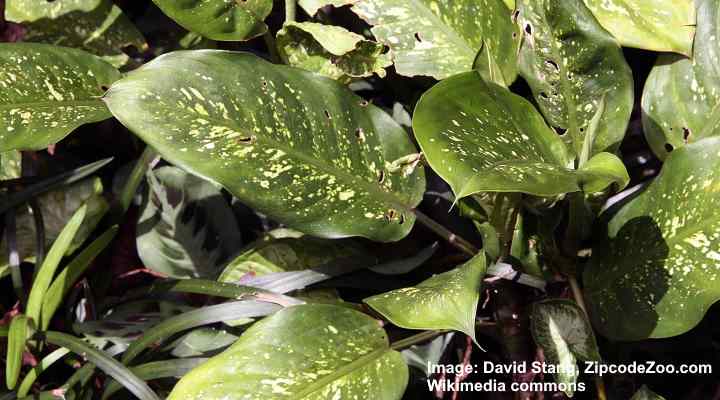
Dieffenbachia amoena includes several cultivars with decorative variegated leaves
As with most tropical houseplants, Dieffenbachia prefers moist soil with good drainage. The best kind of potting mix for dumb canes is a mixture of regular potting soil and perlite. The addition of perlite helps improve soil consistency to allow excess water to drain well.
Dieffenbachia isn’t fussy about the kind of soil you use for planting. The essential requirement is that the potting medium doesn’t become soggy or waterlogged. It’s crucial to avoid overwatering plants. So, mixing in pumice, perlite, or coarse sand will help to prevent soil moisture issues.
One excellent tip for getting the best soil consistency for dumb cane plants is to put a layer of pebbles in the base of the pot. The small stones help water to drain easier through the pot’s drainage holes. The extra space at the bottom of the container also improves airflow to help Dieffenbachia plants get the nutrients and oxygen they need for healthy growth.
Dumb Cane Plant Watering Guide

Dieffenbachia seguine ‘Tropic Snow’ has large creamy-pale green leaves with darker green margins and midrib
Only water species of Dieffenbachia as often as the top layer of soil dries. Allowing the top 1” to 2” (2.5 – 5 cm) of soil to dry prevents overwatering the plant. This watering schedule keeps the potting mix around the roots moist, but not overly damp. Signs of overwatering include dumb cane leaves that turn yellow.
The best way to water Dieffenbachia is to drench the soil with water that is at room temperature. Pour in enough water until it starts draining from the drainage holes. Then, allow all the excess water to drain. The next time you should water the plant is when the top layer of soil is dry.
Deep, thorough watering allows enough moisture to keep the roots hydrated. When it comes to watering dumb cane and leopard lily plants, it’s best to err on the side of caution. Watering less often is better than frequently drenching the potting soil. Dieffenbachia is a hardy plant species that can tolerate some drought.
One of the watering mistakes to avoid when it comes to Dieffenbachia is to give a little water frequently. Watering plants this way tends to create a damp environment at the top of the soil and moisture can’t penetrate down to the roots. So, even though you water your plant, it could show signs of underwatering.
Some signs that your Dieffenbachia is suffering from incorrect watering include:
- Shriveled leaves caused by underwatering.
- Fungus gnats that live in plant soil due to watering little and often.
- The appearance of white mold on soil because the potting mix is too damp.
- Drooping, discolored leaves because of root rot and soggy soil.
Temperature for Growing Dumb Cane Plants
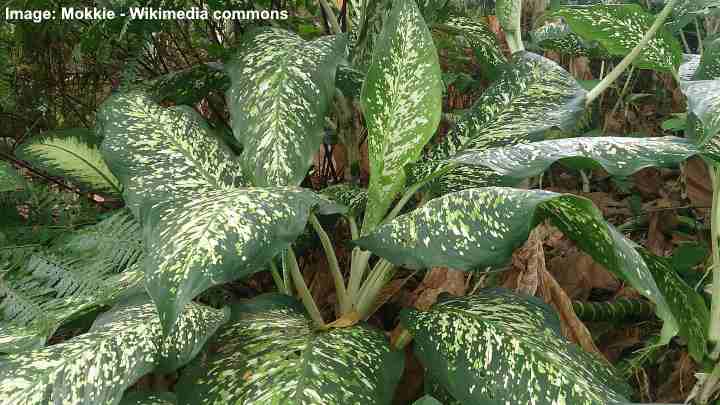
A picture of Dieffenbachia ‘Besar Putih’
Dieffenbachia thrives in average room temperature—making them the perfect, low-maintenance houseplant. Keep the temperature between 65°F and 75°F (18°C – 23°C) for the best growth. Dumb cane plants will grow in temperatures between 40°F and 60°F (4°C – 15°C), but the growth rate will slow down and almost stop.
A challenge of growing dumb cane plants indoors is to avoid sudden temperature fluctuations. In summer, cold drafts from open windows or the air-conditioning unit can cause leaves to curl or stems to droop. Temperature issues in winter can be due to the Dieffenbachia being near hot radiators.
Dieffenbachia plants grow well outdoors in USDA zones 11 and 12. If you live in colder climates, you can take dumb cane plants outside to grow during the summer. As long as the temperature doesn’t drop below 60°F (15°C) and it’s in a shaded or partly shaded place, the plant will grow well and stay healthy.
Humidity Requirements to Grow Dieffenbachia Indoors
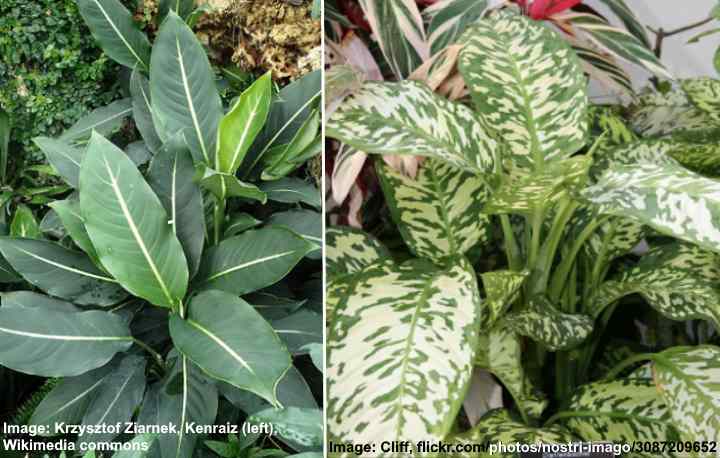
Dieffenbachia oerstedii (left) and Dieffenbachia ‘Tropical Rain’ (right)
Dumb cane plants prefer high humidity—similar to their native tropical regions. However, this non-fussy houseplant adapts well to average room humidity. If you notice that the leaf tips start to brown, you should try and increase air moisture. The easiest way is to mist the plant leaves once or twice a week.
It’s vital to regulate humidity in line with the temperature. Too much air moisture in cooler temperatures can result in fungal diseases developing. This can show up as brown or black spots on leaves. In winter, household heating tends to cause dry air, so you may have to mist more often.
Dieffenbachia plants are excellent shower plants. These indoor plants tolerate low light, but they love warm temperatures and humidity. So, they will grow well in bathrooms, kitchens, and other warm rooms where there is little natural light.
Dumb Cane Speed of Growth

Dieffenbachia ‘Reflector’ (left) and Dieffenbachia ‘Galaxy’ (right)
Dieffenbachia plants grow vigorously in bright, indirect light and warm temperatures. Under ideal conditions, the plant can reach about 3.5 ft. (1 m) high with sizeable bushy foliage. Dumb cane plant’s growth rate slows considerably in winter and cooler temperatures. Also, a lack of bright light can affect how fast this houseplant grows.
Please read this article on tall houseplants if you are looking for indoor plants that grow over 3 feet (1 meter) tall.
Flowers on Dieffenbachia Plants
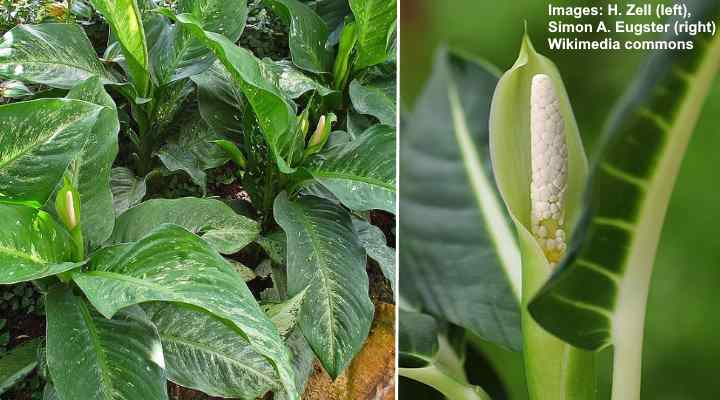
In this picture the creamy-white spike (called spadix) is the flower, and the pale green modified leaf is called bract or spathe
Although Dieffenbachia plants are flowering tropical plants, they rarely—if ever—flower indoors. If dumb cane plants bloom, they produce flowers that consist of a spathe (which is actually modified leaf) and spadix. The types of Dieffenbachia flowers look similar to other aroid plants in the family Araceae, such as species of anthurium.
Because dumb cane flowers are relatively insignificant, it’s best to snip the flowering stems. Cutting the stems helps concentrate energy into vigorous plant growth to ensure healthy, vibrant foliage.
The Best Way to Fertilize Dieffenbachia
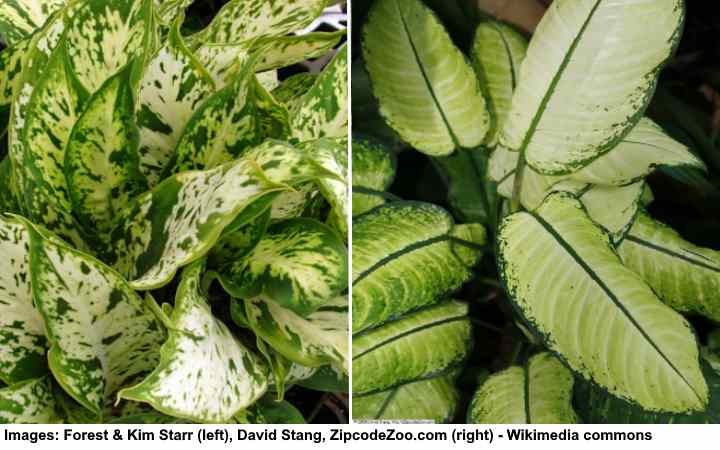
Cultivars of Dieffenbachia maculata. ‘Rudolph Roehrs’ cultivar is on the right
Feed a dumb cane plant once a month with regular houseplant fertilizer to ensure fast growth. You should only fertilize these plants during the growing season—spring and summer—and stop feeding during winter. However, you may find that if you care well for your Dieffenbachia, you don’t have to use any fertilizer.
If you decide to use fertilizer, it’s essential to flush the soil every so often. A buildup of mineral salts can affect leaf growth and cause them to curl and develop brown tips. Every three months, pour water through the potting soil for two to three minutes. Drenching the soil this way helps to remove excess fertilizer.
How to Prune Dumb Cane Plants for Best Growth
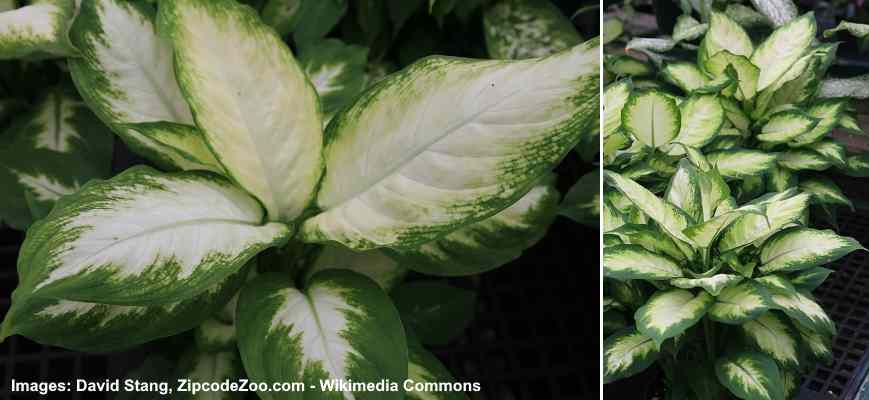
Dieffenbachia ‘Compacta’ (in the picture) has more compact growing habit than other varieties
Pruning Dieffenbachia in spring encourages bushy, healthy growth, and improves the plant’s appearance. Yearly pruning prevents leggy stems from growing and rejuvenates growth. You should also cut off any leaves or stems that are brown or dead. Pruning helps to control how high dumb cane plants grow.
To remove straggly stems or unsightly foliage, cut the leaf stem just above the node. The new foliage should start growing just below the node. If you want to encourage bushy, vigorous growth, pinch off new growth regularly to get a more compact appearance.
Propagating Dumb Cane Plants
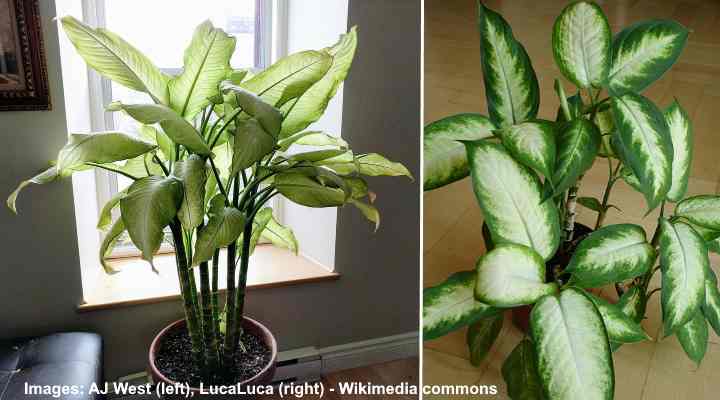
You can easily propagate Dieffenbachia by rooting cut stems
The best way to propagate Dieffenbachia plants is by rooting stem cuttings. You can use stems removed from pruning to grow new dumb can plants.
Ensure that the stems you use for propagation have a node at the end. Leave the cut stems to dry for one day. Then place sideways on moist sand or perlite until roots appear. You can then transfer the rooted Dieffenbachia cutting to a new pot.
You can also root stems in water by placing them in a jar of water. Put the jar in a bright, warm place and wait for roots to appear before transferring to potting soil.
How to Repot Dieffenbachia Plants
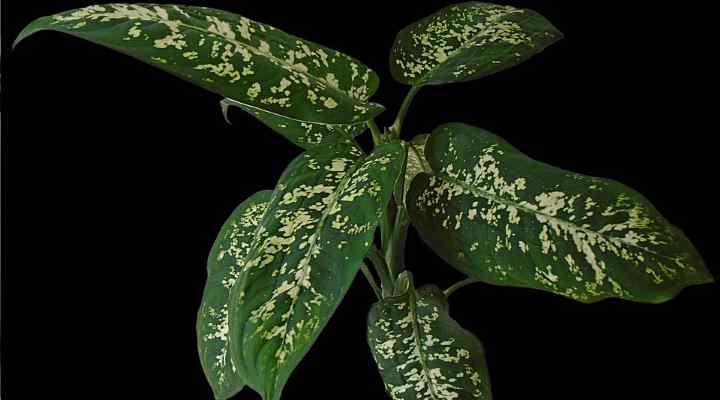
Dumb cane plants require repotting when they become rootbound. Because these houseplants are easy to care for, they don’t need repotting very often. You should look for signs of slow growth or roots poking out the pot’s drainage holes to know when to repot the plants.
To repot your Dieffenbachia plant, choose a container that is one or two sizes bigger and which has drainage holes. Carefully ease the plant out from its current container. Remove excess dirt from the roots and free any tangled ones. Look for brown, mushy roots and trim as necessary with clean, sterile equipment. Replant in a new container with the appropriate type of potting mix.
It’s important to remember that repotting can stress the plant—so, only repot when necessary. Also, species of Dieffenbachia contain poisonous sap that can irritate the skin. Therefore, it’s advisable to wear protective gloves when handling cuttings.
Pest and Diseases Affecting Dieffenbachia Growth
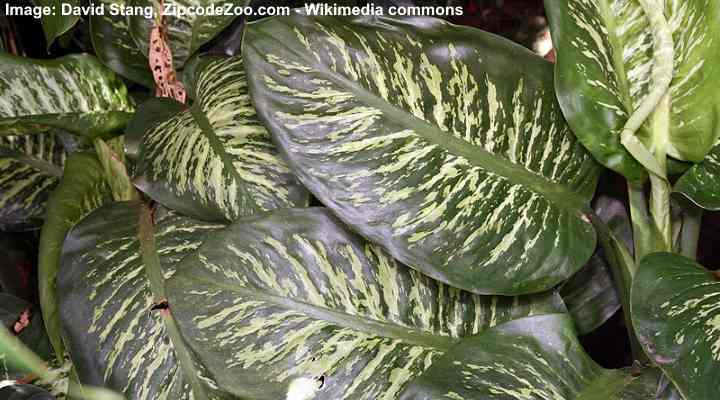
The types of pests to affect Dieffenbachia are spider mites or mealybugs. However, the good news is that pests rarely affect dumb cane plants. However, if you get bugs on these houseplants, then it’s crucial to get rid of the plant pest quickly. Usually, insecticidal soap is the best way to remove these pests for good.
The signs of mealybugs on dumb cane plants are tiny cotton-like growths on the stems and under the leaves. Spider mites are sometimes too small to see. However, the tell-tale sign of these houseplant pests is webbing under the leaves and on the stems.
Diseases that affect Dieffenbachia plants are usually due to overwatering. The golden rule when watering dumb cane plants is to only water when the soil partly dries.
Are Dieffenbachia Plants Toxic?
Dumb cane plants contain poisonous substances—calcium oxalates—than can cause irritation and swelling.
Medical reports say that you should never ingest any part of Dieffenbachia plants. Ingesting the plant can cause swelling, burning, and ulcers in the mouth and esophagus. Also, handling the plant can cause skin irritation or allergic reactions. (1, 2)
Dieffenbachia plants are also toxic to cats, dogs, and other household pets. The American Society for the Prevention of Cruelty to Animals (ASPCA) says that signs of poisoning include the following: (3)
- Oral irritation
- Burning in the oral cavity
- Excessive drooling
- Vomiting
- Difficulty swallowing
FAQs About Growing Dieffenbachia Indoors
What are White Spots on Dumb Cane Plant Leaves?
If the white spots on Dieffenbachia are fluffy or furry, chances are they are mealybugs. Wipe with insecticidal soap to remove them. Small white spots on dumb cane leaves could also be calcium from hard water. The solution for this issue is to leave tap water out for 24 hours before using to mist the leaves.
Why are the Leaves of Dieffenbachia Turning Yellow?
Common reasons for dumb cane leaves turning yellow include: overwatering, too much sunlight, lack of humidity, or a nutrient deficiency. To sort these problems, you will have to use a process of elimination. So, either ease up on the watering frequency, change location to a shadier place, or fertilize monthly.
Why are Dumb Cane Plant Leaves Leaf Tips Brown?
A lack of humidity is the most likely reason why Dieffenbachia leaves turn brown. The solution is to mist the leaves more frequently. However, if you notice that the whole leaf is turning brown, it could be too much water. Check the soil for moisture before watering.
Related articles:
